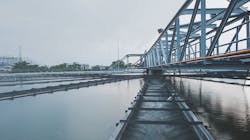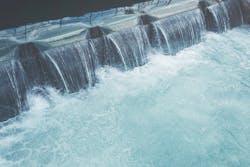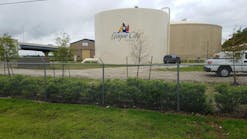Water utilities must deal with unknowns every single day, from extreme weather to security threats. Here, Gary Wong, Principal – Global Water Industry, OSIsoft, outlines the role of data in the pursuit of resilience and how to overcome challenges along the way.
Q: How would you define resilience?
GARY WONG: Resilience is about being prepared for the next unknown. From a utility’s perspective, that could be drought, fire, storms, or even another pandemic. We don’t know what it might be, but being able to react in time or, better yet, foresee something that’s going to happen in order to prevent a system upset is what resilience is all about.
Q: We often hear the phrase ‘actionable intelligence.’ What does that really mean?
GW: To be resilient, you have to make decisions, whether in real time or as part of long-term planning. You need data to do that, but not raw data. It must be meaningful, with context, so it can be used to effect a certain outcome or prevent something from happening. That is actionable intelligence.
Q: The amount of data available can be overwhelming. Is there too much? How do you make sense of it?
GW: People often feel like there’s too much data because it exists in a lot of different silos. I don’t believe there is too much data; rather, I think it needs to be managed properly. It’s important to understand that data isn’t the same as information. We need context to get an understanding of what that data means so we know what we’re looking at and can make a decision. This is true of other systems, as well, like artificial intelligence and neural networks. Those systems also need context; you can’t just throw completely raw data at them and expect them to deliver something meaningful. The data must be massaged, cleansed.
Q: What exactly do you mean by context?
GW: The data has to relate to something around it. For example, if you have temperature readings, you need to know what kind — Water? Air? These parameters are critical for giving the data meaning in order for automation systems to help make decisions.
Q: In terms of sustainability and resilience, where do you think water utilities stand today?
GW: I’ve seen some really good progress, especially over the past year because of the pandemic. Utilities are realizing the value of remote monitoring, for example. Those who had the ability to remotely monitor what was happening in their plants and systems didn’t have to send people on site unless it was an emergency. On the other hand, if a utility didn’t have that capability, they physically had to send people, which meant risking their health and safety, or having to quarantine on site for a period of time. The latter is not sustainable; it takes a toll on everyone’s well-being, strains resources, and jeopardizes people’s health. In many ways, the pandemic has been a wake-up call for utilities to assess their sustainability and resilience.
Q: Do you believe digital technologies like these will change how utilities do business?
GW: We are already seeing it. They’re much more receptive to digital solutions and the whole “smart water” movement, implementing more automation, more remote monitoring, more sensors. But it all comes back to using that data. There’s no point in putting all those tools in place if you aren’t going to collect the data, give it meaning, and make decisions with it.
Q: If you think of resiliency as a chain, where are the weak links and how do we strengthen them?
GW: In talking with a number of our utility customers, one weakness that came up was reliability of data (or data resiliency). You’re as resilient as your weakest link, let’s say, and if we can agree that data is a big part of that, then data resiliency is important. First, let’s assume we have the instrumentation and the sensors in place. Then are we able to gather that data, make sense of it, and then take the necessary action based on that? So, that’s one aspect of data resiliency. The other aspect, of course, is security. And we saw this recently come up in Oldsmar, Florida. Having controls and automation is part of critical operations, but it also means that we want to be very restrictive in terms of who gets access to our systems — and the fewer people the better. A lot of the data we’re talking about is monitoring; we’re not talking about controls of the system. So managers, decision makers and engineers should be able to see the information but with read-only access. They don’t need access to a control system, automation system, or SCADA system. So cybersecurity is part of being resilient as well.
Q: There have been cybersecurity breaches over the years in the water industry, from ransomware to controls issues, but Oldsmar really got people’s attention. Why do you think that is?
GW: When it comes to cybersecurity, there are different types of threats. It could be ransomware, it could be intrusion into the system where they’re just looking around. But with Oldsmar, the bad actor had control over the existing automation system so they could change set points and increase the chemical dosage. If an outside third party has control of your systems, that’s very bad. And if it goes undetected, who knows what they might do. I think people really took note of that. And that’s why there needs to be this abstraction level, a separate layer outside of the control and automation system where people can view read-only data for the purposes of analysis and visualization. Moving the data up a level keeps it nice and safe.
Q: Do you think fear of a cyber breach or intrusion is impacting the adoption of automation technologies?
GW: We’re dealing with the internet and the cloud every day — every time we make an online transaction or use our credit cards. I think automation has proven that it makes our lives easier and, for utilities, more efficient. At the same time, there are best practices around security. Decision makers need to understand what those are. Examples like Oldsmar are very rare. But it’s a wake-up call for us to recheck the security measures we have in place.
With automation and control systems, the best security is to restrict system access to only those who need it, like operations; no one else — not the general manager, not the water quality engineers. There are very secure ways to take the data being generated from those automation systems up a layer so it becomes read only, and that’s where you can do analysis and visualization.
Q: Obviously security is an issue that needs to be considered very thoroughly and carefully. But do you have any important ‘quick tips’ for utilities reading this?
GW: Yes. One is to change any of the default passwords that exist with your systems. Next, check the access list and reduce it to key personnel. And third, consider a security audit. There are companies that can do a very robust security analysis your system.
Q: Besides the security protocols that a utility implements, what kinds of security considerations might be ‘built in’ on the programming side of automation systems?
GW: In our case, we have many critical infrastructure utility customers, like power, water, and nuclear facilities, that use the PI System. When the PI System talks to automation systems and control systems, the data that flows through the system is one-way only. It comes up into the PI System and from there, it becomes completely read only. No data goes back into the controls or automation system. In addition, PI System software is tested at all the national labs for security.
The PI System is also fully compatible with leading data diodes, which are pieces of hardware that basically transmit the data through light. We can set a PI System on one side of the diode and a PI System on the other side of the diode. PI will collect data on one side and then send it through the data diode, through light, and the PI system on the other side will capture it.
That is ultimately the most secure approach; an intruder would have to somehow intercept light and decipher that. Firewalls are very secure too, but this is an extra level that we see some of our customers implement.
Q: What is the role of people — the human element — in adoption of these smart systems?
GW: We hear a lot about aging workforce and what we’re starting to see is, as younger workers enter into the water industry, they kind of expect digital information on demand, at their fingertips. They’re not shy about using technology. This diverse and younger workforce, in turn, is starting to push some of the smart technology in order to have more information available quickly. There’s always going to be resistance to change, but as we start to see more of the benefits, I think that rollout can happen more quickly. I’m not saying everyone has to jump to the end right away; it’s a journey. The important takeaway is that utilities, whether small or large, should start somewhere.
At the same time, there are cases where someone may have had a bad experience with technology in the past and that bitter taste can linger. I think that’s why it’s really important to look at proven off-the-shelf solutions, and talk with peers and others in the industry.
Q: There are many who believe their system works just fine. Why should those individuals consider smarter systems?
GW: There’s always the argument, “If ain’t broke, don’t fix it.” But we’ve consistently seen where utilities that have started the digital transformation journey are more efficient. They have more flexibility, they are more resilient. I would come back to the very unfortunate COVID-19 pandemic and how it has affected utilities. Some, not very much at all; others, almost devastating. In terms of resilience, those systems that have moved away from manual, paper-based processes have fared much better over the last 12 months than those who haven’t.
Q: Can you share any digital transformation success stories?
GW: About five years ago, a massive fire broke out in Colorado Springs. The water utility didn’t have remote monitoring capabilities of some of its fire hydrants so they had to send people, risking their lives, into the areas where there was fire to see if there was enough water pressure at the hydrants for firefighters. This was clearly a dangerous and unsustainable process. So, they deployed sensors to monitor flow and pressure. Now, the next time they had a fire, they could clearly see if there was enough water pressure available. That’s one simple example. You know, the argument, well, we don’t need that, or we just send a person out there.
Another good example is Jacksonville Electric Authority (JEA) in Florida. This multi-service utility provides power, water and wastewater services in the Jacksonville area. During storm season when hurricanes are active, there could be power outages. So JEA needs to know where to send crews, where they need to have their generators (they have multiple generators), and monitor the amount of fuel in the different areas to run the generators. JEA has a real-time dashboard of its entire region, including a map with real-time information from weather forecasts, Doppler radar, and all their wet well pumping stations. If a storm hits,
JEA instantly knows where it has issues and where to send people and crews. And, sometimes they can even be proactive because they see the weather pattern coming in. All that data helps them forecast and figure out where they need to send people or how much wastewater they need to pump down in advance.
Before, crews would be moving around, but JEA didn’t know who was moving where or where they needed to go. Now JEA can see it all from one command center.
Q: How can operators maximize the value of their automation systems, SCADA controls, etc.?
GW: I suspect many utilities have put a lot of effort and money into implementing these systems, but they might not be getting enough value out. Part of the reason is that data is locked away and not easily accessible. I think that’s where they should spend the effort: focus on smarter, more efficient, easier ways to use the data they’ve gathered in a more meaningful way to drive that actionable intelligence and be more resilient.
I recommend utilities look at technology in terms of an investment that should — and will — see a return; don’t look at it as a cost center. Off-the-shelf software can help. It not only increases the speed to value (because you’re not having to wait six months for something to happen), it doesn’t require extensive IT resources and the ongoing maintenance and support is much lower.
So, utilities should look for that out-of-the-box solution that can seamlessly and easily present the information available to them and unlock the value of that data. The right tool can manage data from all the various silos and make it easily available with context, so you can start analyzing it and don’t have to call someone else and wait two weeks for a simple trend report.
At the end of the day, the whole idea of self-service to information is what we’re really striving to achieve. WW





